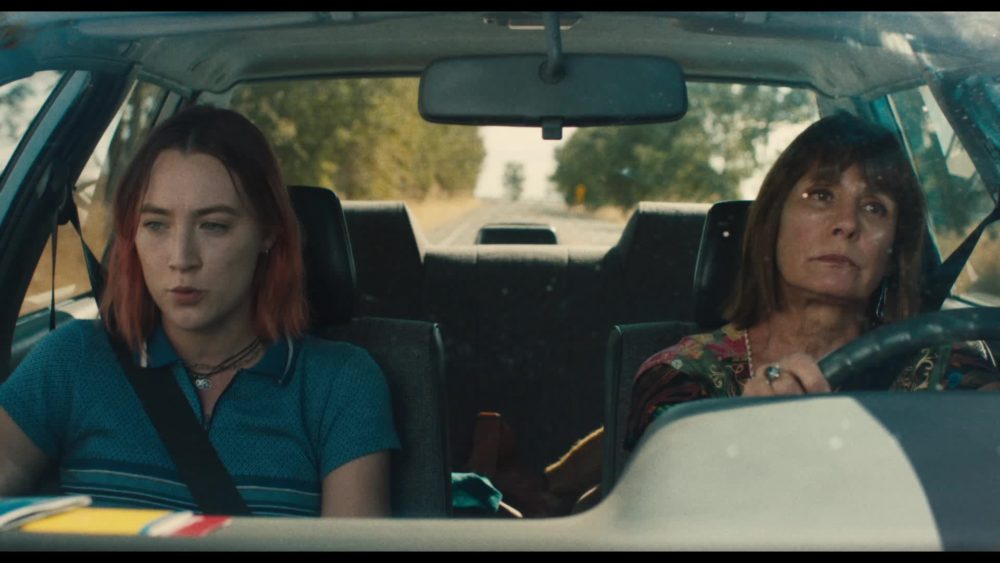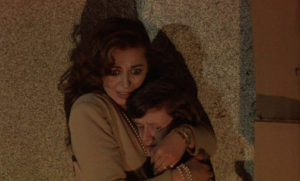
The best part about writing reviews for a friend-run website so anti-clickbait it’s practically anti-click is the freedom to write about a movie three weeks after its initial, limited release. So here I am having just seen Lady Bird, which has just made its way out to the little people. I say that like I don’t live in New York. I do, but catching a $20 train from Long Island to see a movie is for the wealthy. Thank God this movie made it out here. Where better to watch Greta Gerwig’s sketch of Sacramento than in the suburb I grew up hating and not 15 minutes away from my Catholic high school?
Lady Bird, a film primarily about a young woman who takes that name (Saorsie Ronan) and her mildly strained relationship with her loving but difficult mother (Laurie Metcalf), adopts its lead character’s perspective on the city of Sacramento. To Lady Bird, everything is happening on the other side of the country, in New York, and Sacramento may well be the least interesting city in California. Accordingly, it’s a place drawn with the ambivalence of a teenager desperate to escape their hometown to anywhere more culturally significant. Gerwig shoots storefronts, houses, and roads with dry familiarity and rarely establishes a space from the outside so that every place Lady Bird inhabits, at least for the first part of the movie, appears part of a dull routine. Exceptions to that rule include the beautiful blue house she passes on her way to school: if she can’t escape to New York, then she can at least aspire to cross class lines. But in the film’s second half, in which Lady Bird makes a batch of new friends and gets a glimpse at how the other half lives, even potential wealth proves too little a consolation prize. Christine “Lady Bird” McPherson needs out of this town.
Her mother, though, needs her to stay. However much she veils it in financial protestations and “you’ll never amount to anything” scoldings, Marion clearly wants her daughter to remain in California. Lady Bird and her mother are a richly realized pair and none of their time on screen together rings false or is one-dimensional. Happy mother-daughter moments break down at the mere mention of New York and arguments about a passive aggressive remark end in the discovery of a beautiful dress at a thrift store.
The opening scene is emblematic of their relationship. Coming home from a college road trip, Lady Bird and Marion have just finished listening to The Grapes of Wrath on tape. Lady Bird reaches for the radio dial but her mother, moved to tears by Steinbeck, insists on conversation. Bad idea. Soon, New York schools are mentioned, and the long, apparently lovely road trip is ruined. The ensuing fight sees Lady Bird jumping out of the moving car, breaking her arm. Her cast reads “Fuck you, mom.” Over the course of the film, they fight and reconcile repeatedly as Lady Bird gains new friends, loses old ones and dates a couple of boys in her last year of high school.
If that sounds like a movie that’s been made a thousand times before, another low-key American coming-of-age film that ends in minor epiphany, well, it is. But Greta Gerwig has made the best possible version of that particular movie without modifying much of its defining schema. No, what makes Lady Bird stand apart is how closely observed and natural every bit of minutiae is. Every detail is right and even the (very funny) jokes feel not constructed, but grown. Sometimes it’s hard to put into words why a detail is perfect, like when Timothée Chalamet’s hand-rolled cigarette-smoking cool kid is introduced reading A People’s History of the United States. It’s easy to imagine another filmmaker giving him Palahniuk (too dumb) or Kerouac (too cliche) or Nabokov (more undergrad cool than high school). But Howard Zinn just feels perfect as an introduction to that character, who later deflects a conversation about bad sex by invoking the US invasion of Afghanistan (the year is 2003). No disrespect to Zinn, of course. In her solo directorial debut (she previously co-directed Nights and Weekends with Joe Swanberg) Gerwig makes her intelligence obvious and makes meticulous filmmaking seem effortless.
Towards the end of the film, a nun (Lois Smith) reviewing Lady Bird’s college essay remarks that she must love Sacramento to have rendered it in such detail. When Lady Bird protests, the nun offers that perhaps love and attention are the same thing. It’s a revelatory statement to both Lady Bird’s relationships with her mother and with the city that is, in the end, finally filmed beautifully as if everything in it is new and wonderful. But more than that it’s about Gerwig’s own relationship to the city and more specifically to Catholic school. Allow me to get personal for a moment.
I went to a boys’ Catholic high school and similarly, Lady Bird attends the all-girls school, Immaculate Heart. The nearby Xavier’s School for Ungifted Boys (St. Xavier’s) is Heart’s sister school and their boys attend Mass, stage plays and hold prom with the girls from Immaculate Heart. Her entire social world grows out of her school. Outside of adults and family, she never interacts with anyone in Sacramento that doesn’t go to one of these schools. The structured social space created by Catholic high school creates vague outsider norms and a desire to be in a typical space. Lady Bird’s brother saw a kid get stabbed in public school, but that only seems to increase her interest in public education. Nothing interesting happens in private school. But it does create an undesirable space where the starkly defined class groups are imbalanced toward the wealthy. At tuition-based secondary schools, it’s not uncommon for the working class kids to be in a marked minority. One time a kid laughed in my face when he found out my house only had one bathroom. That really happened. And though nothing that extreme happens in this movie, Lady Bird and her family go to some lengths to keep the reality of their financial situation a secret. Even the way the McPherson house is kept almost perfectly clean indicates a specific kind of lower-class experience, a mix of pride and embarrassment that is terrified of anyone knowing the truth.
And yet most screen depictions of Catholic education, or at least the meme of the same, opt for the outsized, weird, and abusive cliches of rigid structure and nuns smacking students across the hand with a ruler. It’s outdated slapstick and overwhelmingly critical of an institution few have any love for without being detailed or particularly realistic. Immaculate Heart is a modern Catholic high school devoid of most of the tropes associated with that. It’s recognizably contemporary. When Lady Bird attends mass, she half-assedly participates, not bothering to cross herself, gently shrugging her arms up to say “and also with you,” and not receiving Communion. I instantly recognize this ambivalence towards ritual and this in-between state of religious practice from my own high school years. Later Lady Bird and her friend snack on unconsecrated Communion wafers, which I always liked the cardboard taste of. Catholic school here isn’t indicted or sent up so much as revisited in its weird complexity.
Set in 2002, the year the Boston Globe broke the story of the widespread pedophilia among clergy, Lady Bird opts to stay away from that, knowing that it rightly would take over the film. Instead, criticisms of the Catholic Church are spread throughout the lives of rich, kind characters, like the jovial priest (Stephen Henderson) who directs the school production of Merrily We Roll Along and suffers from a terribly repressed depression. Later, the pressure for homogeneity of political thought is addressed in my favorite scene. Anyone with a half-decent sex education (which, I know, is too few) has watched a birth in class. At my school, I had to watch an abortion, which I suppose the teacher (a priest) thought would be so gross as to put me off the whole thing. I responded that I also wouldn’t want to watch a heart surgery, either. When subjected to a similar anti-abortion assembly, complete with disgusting pictures, Lady Bird knows every beat of the speaker’s presentation beforehand. She’s been through this a thousand times before and ultimately responds to the whole thing with a much funnier version of my own response. It’s not ideological validation that makes this scene so immediately special to me, though. It’s that, finally, after years of telling people about anti-abortion assemblies to cocked heads, I find a small reflection of this very specific experience. That it’s being reflected in a film this good is just a bonus.
Jesus, this movie is good.
—
Directed by Greta Gerwig; written by Greta Gerwig; starring Saoirse Ronan, Laurie Metcalf, Tarcy Letts, Lucas Hedges, Timothée Chalamet, Beanie Feldstein, Stephen McKinley Henderson, and Lois Smith; 93 minutes.



 Derek
Derek
 Isabelle
Isabelle